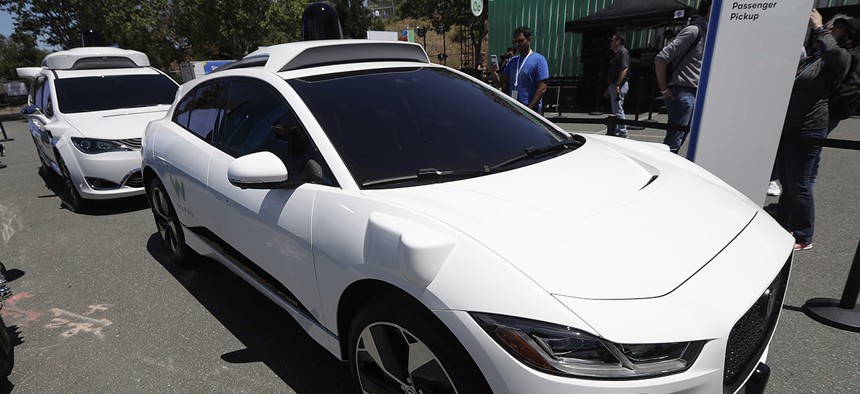Finally, the Self-Driving Car

Waymo cars are displayed at the Google I/O conference in Mountain View, Calif., Tuesday, May 8, 2018. Jeff Chiu/AP
Google’s sister company Waymo built the self-driving car. Now it needs to bring it to life.
CHANDLER, Ariz.—Across Arizona Avenue from Waymo’s self-driving-car showroom sits the Crowne Plaza San Marcos hotel, which is allegedly haunted. According to employees and guests, the ghost can move plates, knock phones off cradles, even—helpfully!—fold clothes. I passed this knowledge on to a Lyft driver, who retorted, “I didn’t know that, but to be honest with you, what isn’t haunted?” Every western boomtown has its ghosts, each wave of fresh pavement and new money disturbing the traces of what lived and died there before.
Chandler, just southeast of Phoenix, has added 220,000 of its 250,000 residents since 1980. Intel, PayPal, the security outfit Northrop Grumman, and a variety of other big companies have set up shop here in the past few decades, chasing tax breaks, a lower cost of living, and lots of square footage. Nothing in Chandler is supposed to look or feel old. Instead, it is either new or waiting to be new, like the scraped-flat parcels of land near what passes for downtown. And now weaving past every green-glass office park, poolside condo, and mobile-home park is the ultimate symbol of newness, the self-driving car.
Waymo, a subsidiary of Alphabet, began testing cars here in early 2017, and the fleet has been growing ever since, serving a handpicked sample of the community through the “Early Rider Program.” Now it is launching to the public under the name Waymo One. In the coming weeks, a growing number of Chandler residents beyond the Early Rider Program will be able to hail Waymos.
Autonomous cars have been under development by various companies for decades, but the industry’s modern era exploded out of a series of Defense Advanced Research Projects Agency competitions in the 2000s, when a few university teams, funded by the military, began to make huge progress on self-driving vehicles. Breakthroughs in technology, mostly in the laser-range-finding systems known as lidars, allowed the cars to understand the three-dimensional space of the world. Mapping projects from Google and others helped encode human rules of the road for machine consumption. And, of course, in recent years, ever more computation and the use of machine-learning models have improved visual processing tasks like pedestrian detection.
The driverless car is a monument to our age, synthesizing everything that Silicon Valley can be: brilliant, farsighted, rapacious, data-hungry, convinced of machine competence and human fallibility. It is tech’s will to change the world made manifest, and it will—eventually, almost certainly—reshape cities in the most mundane and significant ways.
In preparing for Waymo’s continuing deployment, Chandler’s planning commission hewed to the mundane: The primary change it considered was a 10 percent reduction of parking in exchange for developers constructing dedicated pickup and drop-off locations. Such civic administrivia could obscure the fundamental, astounding new fact of the world: Waymo One is an autonomous-car taxi service that normal people—hundreds, then thousands—will use to summon robots for a quick ride to Dee’s Dancewear or volleyball practice or Walmart. There will be many firsts along the way to the self-driving future, but this is the end of the beginning.






